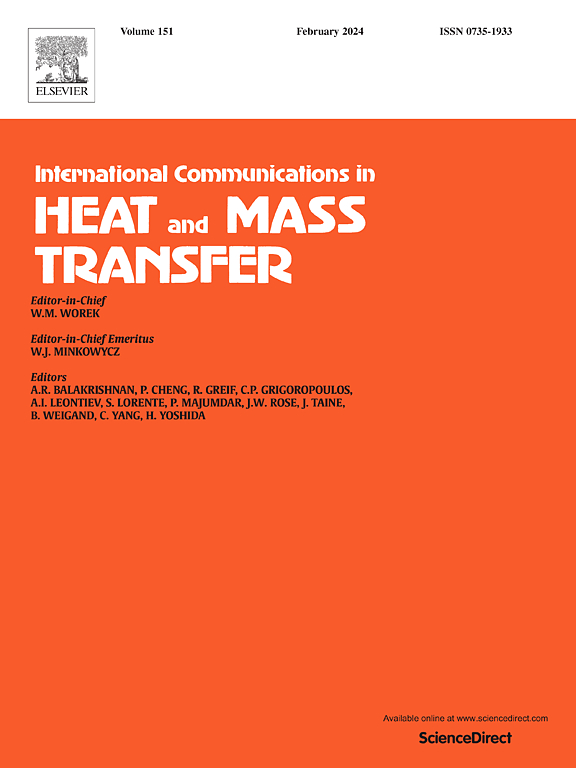聚合物干燥剂轮在全球操作和设计范围内的综合建模和实验验证:有效性和多层感知器模型的比较研究
IF 6.4
2区 工程技术
Q1 MECHANICS
International Communications in Heat and Mass Transfer
Pub Date : 2025-07-17
DOI:10.1016/j.icheatmasstransfer.2025.109376
引用次数: 0
摘要
准确预测聚合物干燥剂轮在耦合操作和几何域上的行为对于建筑级模拟至关重要。本研究建立了三个模型-恒定效率(CE),自适应多网格效率(AMGE)和超参数调谐多层感知器回归器(MLPR) -将十个输入(入口空气状态,面速度,车轮速度和关键几何参数,如车轮面积比,直径和深度)映射到出口过程空气条件。这些模型是在一个广泛的制造商数据集上训练的,并在±5%的范围内满足质量和能量平衡标准的独立实验中进行验证。全局敏感性分析显示,输入之间存在适度的两两相关,但存在强烈的非线性耦合,强调需要将操作和设计视为一个集成空间。AMGE模型精确地再现了每个训练样本,并将实验相对误差限制在- 5.3%的温度和9.8%的湿度。MLPR模型的温度决定系数为0.5820,湿度决定系数为0.7900,而CE模型的温度决定系数分别为0.4863和0.7901。这些结果表明,AMGE方法提供了一种快速的、几何感知的替代方法。因此,其优越的性能为下一代干燥剂空调系统的稳健设计、自适应控制和能源优化带来了希望。本文章由计算机程序翻译,如有差异,请以英文原文为准。
Comprehensive modeling and experimental validation of polymer desiccant wheels across global operating and design ranges: A comparative study of effectiveness and multilayer perceptron models
Accurately predicting the behavior of polymer desiccant wheels across coupled operating and geometric domains is essential for building-level simulations. This study establishes three models—constant effectiveness (CE), adaptive multi-grid effectiveness (AMGE), and a hyper-parameter-tuned multilayer perceptron regressor (MLPR)—that map ten inputs (inlet air states, face velocity, wheel speed, and key geometric parameters such as wheel-area ratio, diameter, and depth) to the outlet process-air conditions. The models are trained on an extensive manufacturer dataset and validated against independent experiments that satisfy mass- and energy-balance criteria within ±5 %. Global sensitivity analysis reveals moderate pairwise correlations but strong nonlinear coupling among the inputs, underscoring the need to treat operation and design as an integrated space. The AMGE model reproduces every training sample exactly and limits experimental relative errors to −5.3 % for temperature and 9.8 % for humidity. The MLPR achieves coefficients of determination of 0.5820 for temperature and 0.7900 for humidity, whereas the CE model attains 0.4863 and 0.7901, respectively. These results show that the AMGE approach provides a fast, geometry-aware surrogate. Its superior performance therefore holds promise for robust design, adaptive control, and energy optimization of next-generation desiccant air-conditioning systems.
求助全文
通过发布文献求助,成功后即可免费获取论文全文。
去求助
来源期刊
CiteScore
11.00
自引率
10.00%
发文量
648
审稿时长
32 days
期刊介绍:
International Communications in Heat and Mass Transfer serves as a world forum for the rapid dissemination of new ideas, new measurement techniques, preliminary findings of ongoing investigations, discussions, and criticisms in the field of heat and mass transfer. Two types of manuscript will be considered for publication: communications (short reports of new work or discussions of work which has already been published) and summaries (abstracts of reports, theses or manuscripts which are too long for publication in full). Together with its companion publication, International Journal of Heat and Mass Transfer, with which it shares the same Board of Editors, this journal is read by research workers and engineers throughout the world.

 求助内容:
求助内容: 应助结果提醒方式:
应助结果提醒方式:


